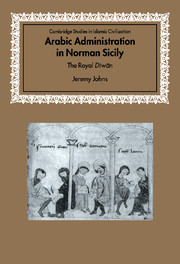Book contents
- Frontmatter
- Contents
- Preface
- Tables
- Abbreviations
- Genealogical table of the De Hautevilles of Sicily
- Note on Measurements
- Introduction
- 1 ‘In the time of the Saracens …’
- 2 ‘When first the Normans crossed into Sicily …’
- 3 ‘Our lady, the Regent Adelaide, and our Lord, the Count Roger, her son’, 1101–30
- 4 The earliest products of the royal dīwān, 1130–43
- 5 The jarāʾid renewed, 1144–5
- 6 The records of the royal dīwān. Part I: the jarāʾid al-rijāl
- 7 The records of the royal dīwān. Part II: the dafātir al-ḥudūd
- 8 The duties and organisation of the royal dīwān, 1141–94
- 9 ‘The people of his state’. The ‘palace Saracens’ and the royal dīwān
- 10 The Norman dīwān and Fāṭimid Egypt
- 11 Royal dīwān and royal image
- Appendix 1 Catalogue of dīwānī documents
- Appendix 2 Provisional catalogue of private documents
- Appendix 3 Abū Tillīs – ‘Old Wheat-sack’
- List of References
- Index
- Titles in the series
10 - The Norman dīwān and Fāṭimid Egypt
Published online by Cambridge University Press: 10 March 2010
- Frontmatter
- Contents
- Preface
- Tables
- Abbreviations
- Genealogical table of the De Hautevilles of Sicily
- Note on Measurements
- Introduction
- 1 ‘In the time of the Saracens …’
- 2 ‘When first the Normans crossed into Sicily …’
- 3 ‘Our lady, the Regent Adelaide, and our Lord, the Count Roger, her son’, 1101–30
- 4 The earliest products of the royal dīwān, 1130–43
- 5 The jarāʾid renewed, 1144–5
- 6 The records of the royal dīwān. Part I: the jarāʾid al-rijāl
- 7 The records of the royal dīwān. Part II: the dafātir al-ḥudūd
- 8 The duties and organisation of the royal dīwān, 1141–94
- 9 ‘The people of his state’. The ‘palace Saracens’ and the royal dīwān
- 10 The Norman dīwān and Fāṭimid Egypt
- 11 Royal dīwān and royal image
- Appendix 1 Catalogue of dīwānī documents
- Appendix 2 Provisional catalogue of private documents
- Appendix 3 Abū Tillīs – ‘Old Wheat-sack’
- List of References
- Index
- Titles in the series
Summary
In Chapters 1 and 2, it was argued that the origins of the Arabic administration of Norman Sicily are to be sought in the pre-conquest administration of the island, and in the adaptation of its practices and records to post-conquest needs. Chapter 3 showed that, after an initial burst of activity, Arabic all but disappeared as an administrative language from 1111 until after Roger's coronation. And yet, within a few years of 1130, as may be seen in Chapter 4, Roger was issuing Arabic and bilingual documents which had been produced by a professional and sophisticated Arabic dīwān. During the 1140s, and especially during the renewals of 1145, which were discussed in Chapter 5, the Arab scribes of the royal dīwān demonstrated themselves to be masters of the secretary's art as practised in contemporary Islamic chanceries. This dramatic renaissance of the Arabic administration was confined to the reign of King Roger. Thereafter, until the fall of the dynasty, the royal dīwān continued to develop along the lines then laid down, but did not undergo further revolutionary reconstruction comparable to that of the 1130s and '40s.
This chapter seeks to answer a series of questions which have, until now, remained obvious but unasked. What were the sources of the renaissance of the Arabic administration? Are they to be found in Sicily, or must they be sought in the wider Islamic world? And, if so, where precisely? And through what channels did they reach the island? Partial answers to some of these questions have already been given in order to support specific stages of the argument.
- Type
- Chapter
- Information
- Arabic Administration in Norman SicilyThe Royal Diwan, pp. 257 - 283Publisher: Cambridge University PressPrint publication year: 2002

